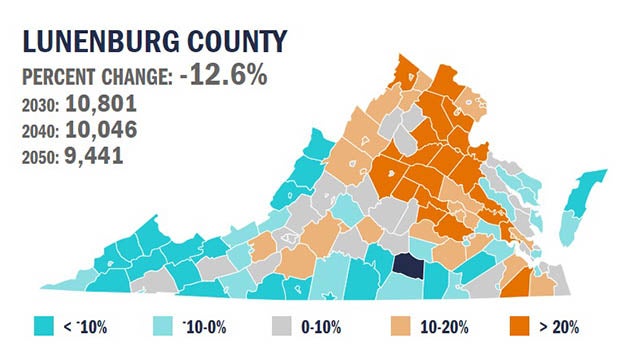Can we fix county’s population problem?
Published 8:00 am Thursday, March 14, 2024

- A look at the current projections for Lunenburg County over the next 26 years. UVA’s Weldon Cooper Center expects Lunenburg to lose almost ¼ of it’s population.
|
Getting your Trinity Audio player ready...
|
By Jeff Moore and Brian Carlton
The K-V Dispatch
Lunenburg County has a population problem. The number is dropping and is expected to keep falling over the next 25 years. In 2000, Lunenburg had 13,146 residents. That fell by 232 in 2010 and another 978 in 2020. Despite a small increase from 2020 to the present day, a new study from the Weldon Cooper Center for Public Service projects that Lunenburg will see some severe losses over the next 26 years.
The odd thing is it actually comes at a time when some rural areas of the state are seeing growth and reversing the fall. Prince Edward, Buckingham, Cumberland and Dinwiddie counties, for example, are actually all projected to grow by several thousand residents over the same time period. It also comes despite several improvements over the last year. Kinex plans to have more than 1,200 miles of broadband laid in Lunenburg and the surrounding area by 2025, giving residents access to high-speed internet. Schools across the county are showing improvement in both chronic absenteeism and test passing rates.
And yet, Lunenburg is projected to both shrink and get older.
“(This) is not unanticipated given the nature of the current demographic trends of lower births, higher deaths and fewer people moving in,” said Shonel Sen, senior demographer from the Cooper Center’s Demographics Research Group, the organization who did the study. Sen wrote that as a statement connected with the study’s release, spotlighting not just Lunenburg but several other parts of the state with similar trends.
In the statement, Sen argued that the data shows counties have to ‘sell’ themselves, they have to convince would-be residents they have what the people are looking for.
BREAKING DOWN THE DATA
Lunenburg County’s population was 11,936 in the 2020 census, and Weldon Cooper Center’s projections show slight growth in 2023 at 12,060. However, the study expects that to decline to 10,801 people in 2030, 10,046 in 2040 and 9,441 by 2050.
Part of that is due to simple age. Amid all age groups in Lunenburg, the county’s population of those 65 and older was the fastest growing between 2010 and 2022, rising 25.9%. It isn’t that more older people are moving in. It’s that those already here are just growing older. A total of 17.3% of Lunenburg residents were 65 or older in 2010. By 2022, that number had jumped to 23.3% and it continues to rise. On the other side, the younger part of Lunenburg’s population is shrinking. The youngest residents, age 0 to 4, made up 5.3% of the population in 2010. That’s down to 4.7%.
Lunenburg County Administrator Tracy Gee said she hasn’t seen the new report yet and can’t comment on its conclusions because she doesn’t know the data used to reach them.
“I would need to know that before commenting,” Gee said. “It is my hope that the estimated figures will be inaccurate for 2030 and beyond.”
WHAT’S THE SOLUTION?
So how do you reverse course? How do you encourage “return migration” and bring people back to Lunenburg County? A study by the U.S. Department of Agriculture highlighted three key points. The good news is that Lunenburg is already working on some of them.
First, you need high-speed internet. That’s not to play games or message friends. You need it to attract businesses. With many companies, internet sales is a key part of their operation. That’s even true for some farms. According to the USDA, internet sales for agricultural products netted a total of $40.2 billion. High-speed internet also gives schools more opportunities, to connect and hear from experts who live thousands of miles away, to experience virtual reality “tours” that link up with their lessons on places like ancient Rome. That’s already in the works, with the Kinex project expected to fully cover Lunenburg County by 2026 at the latest, giving everyone access to broadband high-speed internet.
A second thing needed is to focus on bringing in business. Good-paying jobs will draw workers and their families in. A recent success in that area is the Central Virginia Poultry Cooperative, which launched in February. A farmer-led operation, they sell cage-free eggs to Dutch Country Organics LLC, out of Indiana. In turn, Dutch Country distributes the eggs to places like Walmart, Kroger, Target and Cosco.
Gee also argued that Lunenburg is in a good position to be a ‘bedroom community’ of sorts. That is, people work in other areas and live here. She pointed to the Foreign Affairs Security Training Center (FAST-C) in Nottoway County and several nearby data centers as examples where people could commute from Lunenburg.
And then a third thing the USDA study found was to attract new residents, you need good schools. Companies, the study pointed out, aren’t just looking at one year or two when considering where to move. They looking at 5 to 10 years and seeing if they’ll have a strong workforce. And as mentioned, Lunenburg is seeing progress in that area too, with pass rates improving for state tests and a reduction in chronic absenteeism.
A WORK IN PROGRESS
Gee said all of this is a work in-progress, especially in Lunenburg County’s planning and economic development office, with support from regional partners in economic development.
She also pointed out the county is in the process of updating its comprehensive plans. Gee expects the Weldon Cooper study to factor into consideration, adding that Lunenburg officials are working now on a draft update for the comprehensive plan now.
“I do think the study requires further investigation and this will be a point of discussion in the Comp Plan meetings,” she said. “We will be advertising for public input meetings to be held in April.


